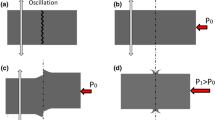Abstract
The finite element method is a powerful tool for the design and optimization of hot forming processes. In order to obtain high accuracy in simulation results, exact knowledge of the process conditions is required. Due to the fact that friction in the contact area has a significant impact on the material flow during the forming process, a realistic description of this boundary condition in the FE simulation is important for the usability of the simulation results. The most important influencing factors are the contact pressure, the roughness of the contact surfaces, the sliding velocity and the flow behavior of the material. Currently, only constant friction coefficients are considered in commercial finite element systems for the simulation of bulk metal forming processes. However, this description does not represent the state of the art in tribology. A new friction model is developed, taking into account the sliding velocity between tools and workpiece. This is confirmed by experimental and numerical investigations on model experiments and industrial process.









Similar content being viewed by others
References
Altan T, Vazquez V (1996) Numerical process simulation for tool and process design in bulk metal forming. Ann CIRP 45(2):599–615
Becker P, Jeon HJ, Chang CC et al (2003) Modelling the Friction interface in bulk forming processes. In: Neugebauer R (ed) 10. Sächsische Fachtagung Umformtechnik in Chemnitz 14.-15.10.2003, Wissenschaftliche Skripten, Zwickau, S. 179–191
Finnie I, Shaw MC (1956) The friction process in metal cutting. Trans Am Soc Mech Eng 78:1649–1657
Neumaier T (2003) Zur Optimierung der Verfahrensauswahl von Kalt-, Halbwarm- und Warmmassivumformverfahren. Ph.D. Thesis, Universität Hannover
Schey J (1979) Metal deformation processes: friction and lubrication. Dekker/Pergamon, New York
Doege E, Bederna C (1996) Analysis of boundary stresses and temperatures in hot massive forming. Prod Eng 3(2)
Shaw MC (1963) The role of friction in deformation processing. Wear 6:140–158
Bernhardt R (1998) Ein Beitrag zur experimentellen und numerischen Analyse lokaler Kontaktspannungen und Kontakttemperaturen in der Wirkfuge von Gesenkgravuren unter besonderer Beachtung des Randreibungsproblems. Ph.D. Thesis, Bergakademie Freiberg
Bay N, Wanheim T (1976) Real area of contact and friction stress at high pressure sliding contact. Wear 38:201–209
Chen CC, Kobayashi S (1978) Rigid-plastic finite element analysis for ring compression. Appl Num Methods Form Proc ASME AMD 28:163
Mikic BB (1972) Thermal contact conductance theoretical consideration. Int J Heat Mass Transf 17:205–214
Alasti M (2008) Modellierung von Reibung und Wärmeübergang in der FEM-Simulation von Warmmassivumformprozessen. Ph.D. Thesis, Leibniz Universität Hannover
Behrens B-A, Alasti M, Bouguecha A, Hadifi T, Mielke J, Schäfer F (2009) Numerical and experimental investigations an extension of friction and heat transfer models for an improved simulation of hot forging processes. 12th ESAFORM2009 conference on material forming, Twente, Netherlands
Behrens B-A, Bouguecha A, Mielke J, Hirt G, Bambach M, Demant A (2010) Investigation and extension of existing approaches to the improved description of friction and heat transfer in the FEM simulation of hot forming processes. Forschung für die Praxis P 772, Forschungsvereinigung Stahlanwendung e. V., FOSTA
Acknowledgments
The authors would like to thank the Institute of Metal Forming (IBF) of the RWTH Aachen University for the experiments of the bulge process with the newly designed die and the data acquisition of the forming forces. Our special thanks are due to the Hirschvogel Automotive Group for providing an industrial forging process. The authors would also like to thank the Simufact Engineering GmbH for the implementation of the new friction model. Moreover, the authors are much obliged to the German Federation of Industrial Research Associations (AiF), the Research Association of Steel Forming (FSV) and the Research Association for Steel Application (FOSTA) for funding the research project P772 AiF IGF 15204 N “Investigation and extension of existing approaches to the improved description of friction and heat transfer in the FEM simulation of hot forming processes”.
Author information
Authors and Affiliations
Corresponding author
Rights and permissions
About this article
Cite this article
Behrens, BA., Bouguecha, A., Hadifi, T. et al. Advanced friction modeling for bulk metal forming processes. Prod. Eng. Res. Devel. 5, 621–627 (2011). https://doi.org/10.1007/s11740-011-0344-8
Received:
Accepted:
Published:
Issue Date:
DOI: https://doi.org/10.1007/s11740-011-0344-8




